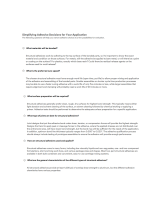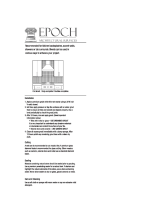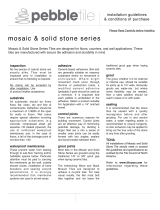Page is loading ...

1
D
I
S
P
E
R
S
I
O
N
A
D
H
E
S
I
V
E
S
C
E
M
E
N
T
-
B
A
S
E
D
A
D
H
E
S
I
V
E
S
Dispersion and reaction adhesives
www.litokol.it
DESCRIPTION
Two-component reactive adhesive Component A consists of inert
load, epoxy-polyurethane synthetic resins featuring a fine grain
size and organic additives. Component B consists of organic
catalysts.
ADVANTAGES
• Suitable for indoor and outdoor applications on floor and wall
even in severe usage conditions.
• Multi-purpose adhesive suitable for bonding various materials
even on non-traditional substrates such as metal, fibreglass, PVC,
linoleum.
• Product featuring high elasticity and excellent water resistance.
• Suitable for simultaneous waterproofing and laying ceramic tiles
or mosaics in shower stalls or wet interior environments.
• Product with very low emission of volatile organic compounds.
Compliant with class A+ according to French Regulations.
EN 12004 CLASSIFICATION
Litoelastic is a class R2T reactive, improved adhesive with no
vertical slip for indoor and outdoor ceramic tiling on flooring and
walls. Conformity of the product with the EN 12004 harmonised
standard is reported in the Declaration of Performance CPR-IT203
according to the European Regulation for construction products
(CPR - Construction Products Regulation No.: 305/2011/EU) and
tested by a notified European body according to system 3
certification.
PACKAGING
5 kg buckets (A + B) Pallet Eur 500 kg
10 kg buckets (A + B) Pallet Eur 400 kg
INTENDED USE
Suitable for fixing all types of ceramic tiles, thin porcelain slabs with
and without reinforcement, glass and ceramic mosaics, all kinds of
natural stones even unstable ones such as green marble, slate
and Serena sandstone, resin agglomerates, thin and flexible stone
plates with polyester backing and fibreglass backing, indoors and
outdoors on flooring and walls on traditional supports or elastic and
vibrating ones such as wood panels, metal surfaces, lightened
panels. Suitable for applications subject to severe operating
conditions such as swimming pools, floors subject to heavy traffic,
tiling exposed to high temperature fluctuation. Typical examples of
application involve:
• The bonding of ceramic tiles and mosaics on wood kitchen tops;
• The bonding of mosaics and ceramic tiles on metallic surfaces for
the production of prefabricated bathrooms;
• The bonding of natural stone even unstable due to to moisture or
subject to staining;
• The bonding of ceramic tiles, mosaics, reinforced slabs, natural
stone or resin agglomerates on top of old ceramic tiles or marble
chip tiles;
• The bonding of ceramic tiles, thin reinforced slabs, mosaics,
natural stone or resin agglomerates on heated flooring;
• The bonding of mosaics and fillets consisting of extruded
polystyrene panels used in saunas, hammam and wellness
centres;
• The bonding of ceramic tiles and mosaics at floor-level ducts and
shower drains;
• The bonding of ceramic tiles and mosaics in swimming
pools;
• The bonding of ceramic tiles and mosaics in swimming pools
even on waterproofed surfaces with Elastocem,Coverflex or
Aquamaster;
• The bonding of ceramic tiles and mosaics in fibreglass
baths;
• The bonding of ceramic tiles and thin slabs, including large format
ones, on outdoor façades;
• The bonding of slabs consisting in resin agglomerates;
SUITABLE SUPPORTS
Cement screeds; Litocem-based screeds; sulphate-based screeds
(anhydrite); smoothing made with Litoliv S40 Eco, Litoliv Extra 15,
Litoliv Express, Litoplan Rapid, Litoplan Smart; in-situ or precast
concrete; supports waterproofed with Elastocem, Coverflex or
Aquamaster; cement plasters; lime/cement plasters;
gypsum/anhydrite-based plaster; wood or metal panels; fibreglass;
PVC; linoleum; parquets; lightened panels.
TILING DESIGN
The durability of ceramic tiling can only be guaranteed by means of
a good manufacturing. We therefore recommend referring to the
national legislation in your country such as for example standard
UNI 11493:2013 for Italy which provides the necessary guidelines
for choosing materials, correct design, use and installation, in order
to ensure the achievement of the required levels of quality,
performance and durability.
By way of example we show some requirements to adopt as a
general rule.
Substrates
Before laying, check that the substrates are clean, free of loose
particles, thoroughly dry and cured, flat and levelled, with sufficient
mechanical strength in accordance with the intended use of the
tiling.
LITOELASTIC
Reactive two-component improved adhesive with no vertical
slip, to lay ceramic tiles, mosaics, natural and reconstituted
stone.

2
D
I
S
P
E
R
S
I
O
N
A
D
H
E
S
I
V
E
S
C
E
M
E
N
T
-
B
A
S
E
D
A
D
H
E
S
I
V
E
S
Dispersion and reaction adhesives
www.litokol.it
Site conditions
Ensure the conditions for temperature, humidity, lighting, etc. at the
time of product application are adequate.
Materials
Ensure all materials involved in tiling (ceramics material, levellers,
adhesives, sealants, waterproofing products, etc.) are suitable for
the intended use and properly stored.
Expansion joints
Verify that the perimeter flexible expansion, fraction and structural
joints are properly designed and prepared. Generally fraction joints
must be provided for 20/25 m
2
partitions
indoors and 9-15 m
2
outdoors. For outdoors, verify that these joints are properly
waterproofed and sealed.
Double coating
When laying outdoors, swimming pools, large formats, floors
subject to heavy or intense traffic, thin slabs, vibrating substrates
and situations where there are large changes in temperature, the
adhesive needs to be applied both on the substrate and the back
of the tiles in order to obtain a full bed of adhesive free from voids.
Grout joints
In all types of ceramic tiling the grout joints must be of suitable
width in accordance with the following parameters:
• Type, format and dimensional tolerances of the tiles;
• Thermal expansion coefficients of the materials constituting the
tiling;
• Mechanical properties of the laying materials;
• Location and path of the joints;
• Mechanical features of the substrate;
• Target environment and planned operating conditions.
LAYING WITH CLOSED JOINTS IS NOT ALLOWED
Any plastic spacers are to be removed before grouting.
MIXING PROPORTIONS
Component A 9.2 parts in weight
Component B 0.8 parts in weight
The two components are pre-dosed each in their own packaging.
PREPARING THE MIXTURE
Pour the Component B (catalyst) over Component A (mixture) It is
recommended to pour the entire content of the catalyst contained
in the package. Mix by using the electric drill equipped with mixing
paddle until obtaining a homogeneous and clot-free mixture. It is
not recommended to carry out the mixing by hand. The packages
of the 2 components are previously dosed so as to avoid any
mixing errors.
APPLICATION
Apply the product with a notched trowel. The notches of the trowel
must be chosen based on the size of the tiles to be applied. In any
case, it must allow for 65-70% adhesive spread on the reverse side
of the tiles in the case of indoor installation and 100% in the case
of outdoor installation, for floors subject to heavy traffic or particular
strain and in the case of swimming pools.
In the case of simultaneous waterproofing and laying of ceramic
material or mosaic in shower stalls or wet indoor environments, a
product layer of at least 1 mm needs to be applied by smooth
trowel on the area to be waterproofed and upon hardening (about
24 hours), apply the product with a notched trowel for laying the
ceramic material.
INSTALLATION OF THE TILES
The tiles are laid on the adhesive applying a consistent pressure to
ensure contact with the adhesive before its drying up which will
occur after 50 minutes. The time of workability of the product in
normal temperature and humidity conditions is approximately 1
hour. High temperatures will shorten these times, lower
temperatures will lengthen them. The tiles must be laid creating
joints with widths suitable to their format. During installation,
respect any expansion or splitting joints. Leave a space of at least
5 mm at the walls or at any surface elevation. The ceramic surface
must be protected for at least 24 hours against water. The
commissioning of tiled surfaces can take place after approximately
7 days.
GROUTING OF TILED SURFACES
The joints between the tiles may be grouted after about 24 hours.
Cement-based Litochrom 0-2, Litochrom 1-6, Litochrom 3-15
sealants, Starlike
®
Monomix polymer mortar or two-component
Starlike
®
and Epoxystuk X90 epoxy sealants may be used for
sealing.
WARNINGS
• Do not add lime, cement or water to the product.
• Apply the product with a temperature range between +10° C and
+30° C.
• Do not apply the product on moist surfaces or subject to rising
dampness.
• Do not use the product for applications not found in this technical
sheet.
INFORMATION ON SAFETY
See product material safety data charts: available upon request.
PRODUCT FOR PROFESSIONAL USE.
SPECIFICATIONS
Laying any type of ceramic tiles, natural stone, glass or ceramic
mosaic, resin agglomerates, thin plates with and without
reinforcement, thin and flexible stone slabs with polyester backing
and glass fibre must be performed with a class R2T two-
component reactive adhesive, improved and with no vertical slip
pursuant to EN 12004 type LITOELASTIC produced by Litokol
S.p.A

3
D
I
S
P
E
R
S
I
O
N
A
D
H
E
S
I
V
E
S
C
E
M
E
N
T
-
B
A
S
E
D
A
D
H
E
S
I
V
E
S
Dispersion and reaction adhesives
www.litokol.it
IDENTIFICATION DATA
Appearance
Component A: thick paste
Component B: thick liquid
Colour
Component A: white
Component B: beige
EN 12004 CLASSIFICATION
R2T - Improved reactive adhesive with no vertical slip
Custom classification
35069190
Storage time
24 months in its original packaging. Preserve with special packaging at very low temperatures.
Protect from frost.
APPLICATION DATA
Mixing proportion
Component A 9.2 parts in weight
Component B 0.8 parts in weight
Mixture life
Approx. 1 hour at T=+23°C
Admitted application temperatures
From +10°C to +30°C
Open time (EN 1346)
> 0,5 N/mm
2
after 50 minutes
Adjustment time
Approx. 1 hour
Cleaning the tools and residues
With water and scotch brite with fresh product.
Upon hardening only mechanically.
Consumption
Mosaics and small formats (spatula 3.5 mm): 2 kg/m
2
Normal formats with larger side ≤ 60 cm (spatula 8 mm): 3.5 kg/m
2
Large formats with larger side > 60 cm (double spreading): 5 kg/m
2
Can be stepped on
Approx. 24 hours at T=+23°C
Waiting time before fully usable
7 days
Waiting time before grouting
Approx. 24 hours
PERFORMANCE
Shear adhesion at initial cutting
(EN 12003)
> 2 N/mm
2
Shear adhesion after water immersion
(EN 12003)
> 2 N/mm
2
Shear adhesion after thermal shock (EN 12003)
> 2 N/mm
2
Deformability
Highly deformable
Application temperatures
From -40°C to +100°C
Resistance to acids
Good
Resistance to acids
Good

4
D
I
S
P
E
R
S
I
O
N
A
D
H
E
S
I
V
E
S
C
E
M
E
N
T
-
B
A
S
E
D
A
D
H
E
S
I
V
E
S
Dispersion and reaction adhesives
www.litokol.it
LITOKOL S.p.A.
Via G. Falcone, 13/1 42048 Rubiera (RE) Italy
Tel. +39 0522 622811 Fax +39 0522 620150
www.litokol.it email: [email protected]
Although the information in this technical chart is from our best experience, it is
merely indicative.
Each specific case must be subjected to practical preliminary tests by the user who
undertakes the responsibility for the final work result.
Chart No. 203
Revision no.5
Date: January 2017
/












